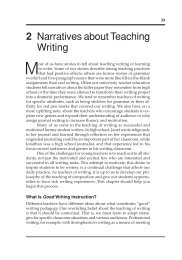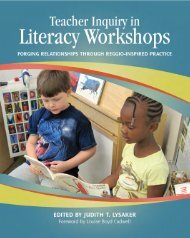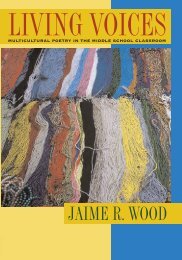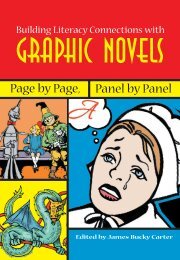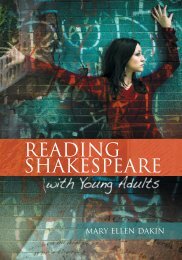Sample Chapter - National Council of Teachers of English
Sample Chapter - National Council of Teachers of English
Sample Chapter - National Council of Teachers of English
- No tags were found...
Create successful ePaper yourself
Turn your PDF publications into a flip-book with our unique Google optimized e-Paper software.
Planning forInquiryIt’s Not an Oxymoron!Diane ParkerForeword byDiane Stephens
viiContentsForewordPrefaceAcknowledgmentsPrologueixxixiiixv1. What Is Inquiry? 12. Inquiry-Based Planning: How Is It Different?How Can I Get Started? 73. A Responsive/Reflective Planning Framework 174. Planning a Long-Term Inquiry: Our Hidden Places Project 315. Teaching for Inquiry 556. Frequently Asked Questions 677. Inquiry and Standards (Or, the Soap Box) 79Epilogue: Vision and Possibilities 85Appendix 1: Responsive/Reflective Lesson Planning Worksheet 91Appendix 2: Helping Families Support Inquiry: A <strong>Sample</strong> Letter 93Appendix 3: Keeping Inquiry in Standards-Based Lessons 97Bibliography 103Author 107
72 Inquiry-Based Planning:How Is It Different?How Can I Get Started?Most <strong>of</strong> us were required to do lesson planning as part <strong>of</strong> our preserviceteacher education. And I’m willing to wager that most<strong>of</strong> us had to do very similar types <strong>of</strong> lesson plans. The formatmight have differed, but essentially, we had to decide on and list ourobjectives, or what the students would be learning; a planned initiatingactivity; a step-by-step, detailed plan for the procedures to follow; anda closing, or evaluative, activity. The procedures usually included allthe questions we planned to ask, in the order we needed to ask them,and, in some instances, even the expected student responses. I rememberhow lost and helpless we felt when those responses didn’t occur.We had no idea what to say or do next. It’s funny to think about it now,but it definitely wasn’t funny at the time!Sadly, it seems that not much has changed with regard to lessonplanning in many preservice teacher education programs. It’s still allabout the teacher. Students have little connection with the lesson exceptas receivers <strong>of</strong> what the teacher has planned and delivered. And <strong>of</strong>ten,what is delivered is little more than what Diane Stephens refers to asthe proverbial “dog and pony show.”I don’t argue with the need for teachers to plan. Artful teachingis indeed planful teaching. But planning needs to be consistentwith what we know about learning. As our understanding <strong>of</strong> learningevolves, planning, too, must evolve to incorporate students’ interestsand wonderings.Some people mistakenly think inquiry-based teaching involveslittle or no planning: “Just let them do whatever they want.” On the contrary,it involves a huge amount <strong>of</strong> planning (see Figure 2.1). I spend longhours reading, thinking through possibilities both alone and with others,and gathering materials and resources. You have to be better preparedthan ever because you have to be able to respond to children’s interestsand questions, both anticipated and unanticipated—and believe me,those wonderful, surprising, unanticipated questions will astound you.
8 <strong>Chapter</strong> 2Myths about InquiryInquiry means doing a report.<strong>Teachers</strong> do little or no planning;they just let students dowhatever they want.<strong>Teachers</strong> don't need to knowlearners, content, or resources;anything goes.Inquiry is an “extra,” not part <strong>of</strong> theestablished curriculum.With inquiry, you can't meetstandards.Facts about InquiryInquiry is learning.<strong>Teachers</strong> do careful planning.<strong>Teachers</strong> need to know learners,content, resources, and processesso as to guide inquiry.Inquiry is the heart <strong>of</strong> the curriculum.With inquiry, you can meet and gobeyond standards.Figure 2.1. Myths and facts about inquiry.Just listen to some <strong>of</strong> them—and these are real questions fromreal kids: I wonder who invented blankets? I wonder if sea monsters arereal? If they had TVs in 1807? If twenty-five elephants can be heavierthan the Empire State Building? What does learning mean? Do bugshave souls? How hot is the sun? What would we look like if we didn’thave any bones? How does the owl twist its head all around? Do fishget thirsty and what water do they drink if they get thirsty?Aren’t kids’ minds amazing? Think about the potential their questionshold for allowing us to take <strong>of</strong>f into experiences and investigationsthat are open-ended enough to enable each student to enter at his or herown level <strong>of</strong> development—which is where differentiation comes in. It’sokay for them to start wherever they are; they’ll continue to refine theirunderstandings as they revisit significant concepts in a variety <strong>of</strong> differentcontexts over the years. The possibilities are endless.The catch, <strong>of</strong> course, is that you have to know content well,because you have to know where you’re going and what you want yourstudents to understand. But that doesn’t mean you have to know all theanswers to all their questions. You simply need to be a learner alongwith your students. When you realize that there are infinite ways to getwhere you want to go, you also realize that your best chance <strong>of</strong> gettingthere is to take the journey with your students, not to drag them alongkicking and screaming behind you. And that means building on theirinterests and questions, starting with what matters to them and weavingthrough the curriculum from there. It’s a different kind <strong>of</strong> planning,one that for me is so much more fun and exciting.
Inquiry-Based Planning: How Is It Different? How Can I Get Started? 9Beginning with Students’ QuestionsLet’s look at some quick examples. Suppose I want my students toexplore linear measurement. There are countless ways we can addressthis mathematical concept while meeting their interests. One year, mykids became interested in treasure maps as we read some adventurestories together. So they used measurement to create their own maps tomark the spot where they had buried our Halloween jack-o’-lantern aspart <strong>of</strong> a scientific study <strong>of</strong> decomposition—and the next spring, theyfollowed those very same maps so they could dig up their “treasure”and find out what had happened to poor Jack.Another year, the kids wanted to find the shortest route from ourclassroom to the cafeteria so that one <strong>of</strong> their classmates who had a brokenleg and had to use crutches would be able to navigate more easily.Out came the string, meter sticks and yardsticks, trundle wheels,chalk, and an assortment <strong>of</strong> child-invented measuring devices, and wewere <strong>of</strong>f on a different sort <strong>of</strong> measurement adventure with an importantpurpose.Still another year, one <strong>of</strong> my first graders asked, “How do youmeasure something that’s bigger than a ruler, if you only have oneruler?” I threw the question back to the class and they worked in pairsto answer it as I watched in amazement. Some kids chose to trace theoutline <strong>of</strong> their ruler over and over on their desktops; others placedthe ruler in a more traditional fashion and “eyeballed” their measurementsor made markings for accuracy; still others cut string to fit theirdesktops and attempted to see how many times it would wrap aroundthe ruler. There were as many different solutions as there were pairs <strong>of</strong>children, all learning more about measurement because <strong>of</strong> this wonderfulquestion that I’d never have thought <strong>of</strong> myself—but you can believeI’ve used that question with many other classes since then!Here’s one <strong>of</strong> my favorite measurement stories: My studentteacher, Kim Min, was required to plan a unit on measurement forher mathematics methods course, but she wanted to link it to our firstgraders’ interests. Kim and I brainstormed several possibilities forincorporating measurement, but none <strong>of</strong> them seemed exactly “right.”Meanwhile, the class had been studying about outer space and thestudents were preparing to share their learning with each other. Kimasked them, “What makes a good presentation?” She had thought thekids would say things like, “Speak clearly,” “Look at the audience,” or“Know your material,” and she was not at all surprised when some <strong>of</strong>those thoughts emerged. But then one child said, and the rest enthusiasticallyagreed, “To have a good presentation, you need a stage!” (You
10 <strong>Chapter</strong> 2never know what kids are thinking!) Kim realized immediately thatthis was the opportunity she was looking for: To explore measurement,the kids would build a stage! And so they did. They spent the next severalweeks planning and building. They learned how to measure theavailable area, create and evaluate blueprints and scale models (firstgradeversions), and finally, to choose and build the finished product.The collaboration and decision making involved in the process wereinvaluable as well, and the satisfaction they gained from actually usingtheir creation for their presentations was immeasurable. The stageremained in our classroom and was well used for both formal andinformal events throughout the rest <strong>of</strong> the school year.I hope the above examples have helped to show what I meanabout how we can link the students’ interests to worthwhile learningin any number <strong>of</strong> ways. In each <strong>of</strong> these four different experiences, thekids were exploring linear measurement, but they were doing so in thecontext <strong>of</strong> a problem that mattered to them. When the interest is there,the learning will follow.Listening to Students’ WonderingsSometimes we can gain insight into students’ thinking, and generateideas for curriculum, by doing a bit <strong>of</strong> eavesdropping. One day, I overheardthis conversation among a group <strong>of</strong> my first graders:Kaeo: Who invented the period?Jon: Maybe someone was accidentally running and the pencilpoint made a dot.Ire: Maybe they dropped their pencil and made a dot.Tavana: Maybe George Washington invented it.Kaeo: Maybe Jesus, when he got bigger and thought about it.Tasha: Maybe God invented it.Kaeo: Maybe it was made <strong>of</strong> rain. God looked at the water andsaw little tiny dots.Tavana: Maybe he couldn’t read the words. They got allsquooshed up.Ire: Maybe he made a dot on paper and said, “Oh yeah, thatcould be a period.”Brittany: It’s good thing. If we didn’t have (periods), it wouldn’tmake sense.I was completely taken with this discussion, not just becausethey were talking about punctuation—which I had not expected wouldbe the topic <strong>of</strong> their conversation at all—but because <strong>of</strong> what they
Inquiry-Based Planning: How Is It Different? How Can I Get Started? 11were asking about it. Even though these students already knew whata period is and how it’s used, they had now begun to wonder abouthow it came to be and why it exists at all. They were ready to explorethe function <strong>of</strong> periods and other punctuation at a deeper level, and Itook full advantage <strong>of</strong> the opportunity. Over the next several weeks, wecompared text excerpts written with and without punctuation, and theeffects <strong>of</strong> each on readers trying to comprehend them; we noticed andexplored the way punctuation is used in a variety <strong>of</strong> texts; and I invitedthe kids to try using punctuation marks they had never used before orin ways they had never tried before, and to share with the rest <strong>of</strong> us. Asa result, many <strong>of</strong> them not only expanded their repertoire <strong>of</strong> punctuationuse, but they began to use punctuation much more intentionally,bringing more clarity to their writing, and they began to gain moremeaning from the texts they read as well. For these students, punctuationhad become much more than a bunch <strong>of</strong> symbols; it had becometheirs, to own and to use.Punctuation is taught as part <strong>of</strong> every first-grade curriculum, so ifwe look at it from that standpoint, we could say I had met that requirementjust by introducing it to them in the first place, and I could haveleft it at that. But I believe they gained much more by going into it somuch further, and I also gained much more from listening to them. Aswith the ruler question, I’ve used some version <strong>of</strong> this “Who inventedthe period?” question with many other classes I’ve worked with in theyears that followed.On another occasion (with a different first-grade class), Aaronwondered aloud while working with a group in the block corner: “Whoinvented numbers?” This conversation ensued:Jason: The factory made it with the machines.Bret: He [Jason] means the page with numbers on it.Aaron: Not by the factory. Who was the first to imaginenumbers?Nick: I think God made the numbers because God made everythingexcept the houses.Jason: I don’t think so, because God just takes care <strong>of</strong> the deadpeople.Bret: Then how did we get born? And how did our parents come?Jessica: God makes us first, and then we grow older.Samantha: But we’re talking about numbers. God put numbersin their brain.Aaron: God passed it on to everyone he knew and they toldeveryone else.
12 <strong>Chapter</strong> 2Keone: I think numbers came from China, because I know theyinvented fireworks so maybe they invented numbers.Brian: I think the governor made numbers. He was the first onealive.Susie: People was born and found work that said numbers andtold to the whole world.Samantha: They would think about how many animals or dinosaursthey killed.Susie: How old they are and when their birthday is.Brandy: They maybe had a little bit <strong>of</strong> stuff and wanted more.Elena: For kids to learn.As I listened, it seemed to me that the natural next step would beto investigate Aaron’s question since so many <strong>of</strong> the kids had alreadybecome involved in his inquiry. So I took them to the school libraryto look for information about the origins <strong>of</strong> number systems, andwe invited Neil Pateman, mathematics pr<strong>of</strong>essor at the University <strong>of</strong>Hawai‘i, to visit our classroom and talk with us further. As with thepunctuation question, I was learning that kids think about things muchmore deeply than we <strong>of</strong>ten give them credit for, and that they’re readyand eager to tackle questions <strong>of</strong> this nature. Are such questions importantenough to spend time on, even if they’re not “on the test”? That’ssomething we need to decide for ourselves. Personally, I see these overheardconversations as gifts handed to us by our students. They’re tellingus what they want to learn; how can we pass up such opportunitiesand still call ourselves teachers?The Unexpected CurriculumOur students are truly our best teachers. They’ve helped me see thatit’s not enough to think <strong>of</strong> curriculum as simply covering material andteaching concepts, and this is the view <strong>of</strong> curriculum I’m sharing here.I’m not talking about scope and sequence charts, sets <strong>of</strong> ready-made lessonplans, or curriculum maps organized around pre-planned contentareas, focused studies, or “essential” questions. There are already manyresources available with that kind <strong>of</strong> information, and I find it useful toconsult them for suggested learning engagements that might fit with mykids’ inquiries. But planning for inquiry is not pre-planning for inquiry,and I hope to show the difference in this book. I want to <strong>of</strong>fer a wayto uncover the unexpected curriculum that can evolve as you considerkids’ questions with a “what if?” frame <strong>of</strong> mind and with an acceptance
14 <strong>Chapter</strong> 2Traditional PlanningStarts with teacher-directed topicsand lessons.Organized by establisheddisciplines, predeterminedobjectives.Teacher preplans unit so knows allsteps ahead <strong>of</strong> time.Teacher selects all resources andactivities.Decisions about “what to donext” are made by writers <strong>of</strong>publishers’ manuals.Teacher directs instruction, studentsfollow.Covers only required curriculum.Study is “finished” when topiccovered.Inquiry-Based PlanningStarts with students’ wonderings andwanting to know.Organized around questions <strong>of</strong>learners.Because unit is not preplanned, teachercan’t know all steps ahead <strong>of</strong> time.Students have choice in selectingresources and activities.Decisions about “what to do next” aremade by teacher and students.Teacher supports and guides learning.Allows for unexpected curriculum.New questions can keep inquiry goingover time.Figure 2.2. Traditional v. inquiry-based planning.Getting Started: A Fishing Expedition<strong>Teachers</strong> <strong>of</strong>ten ask me, “How do you know where to begin?” My answeris, “I don’t know.” You can’t know where your students’ interests lie ifyou don’t know your students yet. So I start each school year with whatI call a “fishing expedition.” I watch, I listen, and I throw out bait basedon what I see and hear. Sometimes I hook them right away, but most<strong>of</strong>ten, I have to keep trying for a while.For example, I might overhear a question the kids are discussingamong themselves, and I decide to throw that question back atthem and see where it will lead. Sometimes, as with the punctuation or“Who invented numbers?” questions, we can take <strong>of</strong>f immediately. Butmore <strong>of</strong>ten than not, the discussion will fall flat and I’ll think to myself,“Well, that didn’t go anywhere.” Most <strong>of</strong> the time, that happens becausethe question had an answer that was simple and quick to obtain, suchas, “What does the inside <strong>of</strong> a cocoa bean look like?” Once you haveyour answer, there’s nowhere else to go with it—unless, <strong>of</strong> course, youhappen to be someone who wants to know everything there is to knowabout chocolate. (If you’re like me and many others, though, you’remostly content just to eat it.)
16 <strong>Chapter</strong> 2for extended investigations and broader connections. It’s not necessarilysomething we do naturally (I didn’t), but with conscious effort,it can be learned (I’m still learning). It takes time, effort, patience, andperhaps a bit <strong>of</strong> luck to uncover learners’ real inquiries, but expendingthat time and effort is critical to the process. There are no “right” or“wrong” inquiry questions. But there are all types <strong>of</strong> questions, rangingfrom trivial to pr<strong>of</strong>ound. As teachers, we need to help kids thinkmore deeply about their world so that their questions will become moreand more thoughtful, and we need to develop in ourselves the ability todistinguish the surface inquiries from the underlying ones. But I thinkit’s only through encouraging and developing our students’ sense <strong>of</strong>wonder that any <strong>of</strong> this can happen. It’s the act <strong>of</strong> wondering, not necessarilythe specific questions they’re initially asking, that establishesan inquiry mindset and gets the process going.If you keep on fishing, eventually you’ll get more than a nibble;you’ll get a bite that will jolt you with its intensity. That’s the one you’llwant to try to follow (see <strong>Chapter</strong> 4 for one example). Sometimes, ifyou’re lucky, that one question will take you further than you everimagined—if you’re not afraid to go with it and see where it leads you,even if you don’t know ahead <strong>of</strong> time where that may be (and if it’s atrue inquiry, you can’t know ahead <strong>of</strong> time). And you can learn how togo with it by asking yourself certain questions throughout the process.That’s where having a framework for your observations and decisionmaking can help. In the next chapter, I’ll share my version <strong>of</strong> such aframework.
In today’s educational climate <strong>of</strong> one-size-fits-all instruction, Planning for Inquiryshows you how to get an inquiry-based curriculum started, how to keep it going,and how to do so while remaining accountable to mandated curricula, standards,and programs. Diane Parker invites you into her classroom to think along withher as she provides an up-close look at the underlying structure <strong>of</strong> an inquirybasedapproach, what such an approach might look like in practice, and how youcan make it happen in your own classroom.Supported by a wealth <strong>of</strong> stories and examples, Parker shares a practical yet nonprescriptiveframework for developing curriculum from learners’ questions andauthentic classroom events. You will be able to adapt this framework for bothshort- and long-term planning with your own students.Planning for Inquiry <strong>of</strong>fers valuable information and much-needed moral supportto those <strong>of</strong> us who believe that there is more to teaching than following a script,and that teachers, not programs, make a difference in the lives <strong>of</strong> children.<strong>National</strong> <strong>Council</strong> <strong>of</strong> <strong>Teachers</strong> <strong>of</strong> <strong>English</strong>1111 W. Kenyon Road, Urbana, Illinois 61801-1096800-369-6283 or 217-328-3870www.ncte.org



